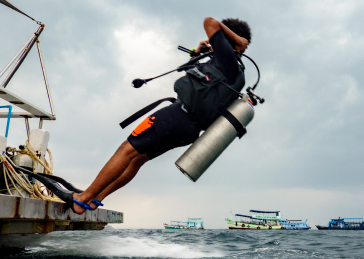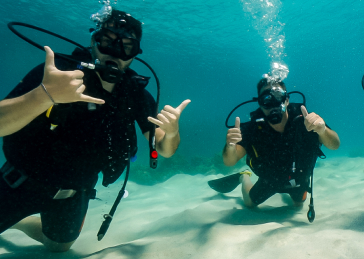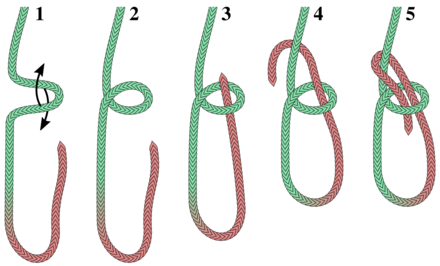1st April 2025
Key Takeaways
Understanding a variety of knots is essential for scuba divers to ensure safety and efficiency underwater.
The Bowline, Reef Knot, and Sheet Bend are foundational knots that serve various purposes from securing gear to connecting lines.
Knowing when and how to use these knots can significantly enhance a diver’s capability to handle unexpected situations.
Regular practice of knot-tying skills is crucial for maintaining proficiency, especially for divemasters and instructors.
Quick-release knots are vital in emergency scenarios, making them a key component of a diver’s skill set.
Tying the Basics: Dive Deeper into Knots
Knot-tying is an art that transcends just being a skill for sailors and climbers; it’s a critical component of scuba diving that every divemaster should master. The right knot can mean the difference between a smooth dive and an underwater complication. Whether it’s securing a buoy line, attaching gear, or setting up an emergency tow, the knots you choose play a pivotal role in dive safety and success.
Why Knots Matter in Diving
Why bother with knots when diving? It’s simple. Knots are the unsung heroes that provide reliability in the dynamic underwater world. They help you manage your equipment and the environment, enabling you to focus on the dive itself rather than worrying about gear coming loose. Moreover, being proficient in knot-tying instills confidence in your abilities, which is contagious among dive buddies and students alike.
The Role of Knots in Dive Safety and Efficiency
Now, let’s get into why knots are not just about convenience but about safety and efficiency. A well-tied knot can hold fast under tension and can be untied with ease when necessary. This balance is crucial in an environment where conditions can change rapidly, and you need to adapt just as quickly. Therefore, knowing your knots can be as important as knowing how to use your dive computer or manage your buoyancy.
Essential Knots for Everyday Diving Tasks
The Mighty Bowline: A Diver’s Best Friend
The Bowline has a reputation for being the king of knots in diving for good reason. It forms a secure loop that will not jam or slip under strain, which is ideal for attaching items to buoy lines or creating a loop in a line for divers to hold onto in current.
Details and Diagrams
To tie a Bowline:
Start by making a small overhand loop in the standing part of the line.
Pass the free end of the line up through the loop, around the standing part, and then back down through the loop.
Tighten the knot by pulling on the free end while holding the standing part.
Common Uses Underwater
Underwater, the Bowline is used to:
Secure a boat to a mooring line.
Create a fixed loop in a line for divers to grasp during ascents or descents.
Attach equipment or lift bags to lines for safe ascent to the surface.
The Simple Yet Strong Reef Knot
“Knot Tying Basics: 7 Essential Knots …” from shedknives.com and used with no modifications.
Also known as the Square Knot, the Reef Knot is ideal for joining two ropes of equal thickness. It’s a binding knot, commonly used for securing equipment or bandaging in first aid scenarios. However, it’s important to note that the Reef Knot is not suitable for joining lines under tension, as it can slip when not under a constant load.
Step-by-Step Guidance
To tie a Reef Knot:
Lay the ends of two lines parallel to each other.
Pass the right end over and under the left end, then do the same with the left end over and under the right.
Pull both ends to tighten the knot flat.
When to Use It
The Reef Knot is best used for:
Securing dive flags or float lines.
Binding objects together for easy carrying.
Temporary repairs on equipment like wetsuits or fins.
The Versatile Sheet Bend: Linking Lines Together
“Sheet bend – Wikipedia” from en.wikipedia.org and used with no modifications.
When you need to join two ropes of different thicknesses or rigidity, the Sheet Bend is your go-to knot. It’s reliable, easy to untie, and strengthens under tension, making it a diver’s best ally for connecting lines of varying diameters.
Visual Instructions
For a Sheet Bend:
Form a bight (a U-shaped bend) in the thicker or more rigid line.
Pass the thinner line through the bight, around both parts of the thicker line, and then tuck it under itself.
Pull both ends of the thinner line to tighten the knot.
Sheet Bend Variations
There are variations of the Sheet Bend for added security, such as the Double Sheet Bend, where the thinner line makes an extra loop around the thicker line before tucking under itself. This is especially useful in heavy seas or when the security of the knot is paramount.
Knots for Complex Scenarios
In diving, as in life, we sometimes encounter complex situations that require a bit more finesse and a robust set of skills. This is where knots like the Clove Hitch and the Double Fisherman’s Knot come into play. These knots are the heavyweights, providing security and strength when you need it most.
The Secure Clove Hitch: Anchoring Made Easy
“Safe Skipper Boating & Safety Afloat …” from www.safe-skipper.com and used with no modifications.
The Clove Hitch is a versatile knot used by divers to secure a line to a post, buoy, or another fixed object. It’s quick to tie and adjust, making it perfect for situations where you need to anchor something temporarily or make frequent adjustments.
Tutorial and Tips
To tie a Clove Hitch:
Wrap the line around the object.
Cross the free end over the standing part, then wrap it around the object again.
Tuck the free end under the last wrap, pulling both ends to tighten.
Remember, while the Clove Hitch is easy to adjust, it can slip if not under constant tension, so it’s not recommended for critical loads.
Applications in Currents and Surges
The Clove Hitch is particularly useful in currents and surges because of its ease of adjustment. If you need to reposition a surface marker buoy or adjust the anchor point of a safety stop line, this knot allows you to do so swiftly and securely, which is crucial when conditions are less than ideal.
Double Fisherman’s Knot: The Unyielding Bond
“Double Fisherman’s vs Overhand Rethread …” from overtheedgerescue.com and used with no modifications.
When it comes to joining two ropes securely, the Double Fisherman’s Knot is unmatched. It’s a bend used to tie two lines together that won’t be easily separated, making it an excellent choice for creating permanent loops in lines or for joining sections of a backup line.
Essential Steps and Practices
For a Double Fisherman’s Knot:
Place the ends of two lines parallel to each other.
With one end, tie a simple overhand knot around the other line, and pull it tight.
Repeat the process with the other end on the opposite side, so the two knots are snug against each other.
Pull both standing lines in opposite directions to tighten the knots against each other.
Importance in Equipment Configuration
Understanding the Double Fisherman’s Knot is essential for divers who configure their own equipment, such as when customizing the length of lines for reels or buoys. This knot’s strength and reliability make it a staple in any diver’s repertoire, especially for those who take on more technical dives where equipment failure is not an option.
Practical Knot Workshops
While reading about knots is a great start, there’s no substitute for hands-on practice. Engaging in interactive knot-tying workshops can significantly enhance your muscle memory and confidence in tying these knots efficiently underwater.
Interactive Experiences for Mastery
Many dive centers offer practical knot-tying workshops where you can learn from experienced divers. These workshops often include underwater practice sessions, which are invaluable for mastering the knots in a realistic setting.
Local Diving Schools and Online Resources
For those who prefer self-study or can’t access local workshops, there are plenty of online resources, including videos and diagrams, that can guide you through the nuances of each knot. Combining these resources with regular practice will keep your skills sharp. For a comprehensive guide on advancing your diving skills, consider exploring Koh Tao: From Open Water Diver to Divemaster.
Quick-Release Knots for Emergencies
Some scenarios require knots that can be released instantly, and this is where quick-release knots come into play. These knots are designed to hold firm under tension but can be undone in a split second when needed, which is essential for emergency situations.
The Life-Saving Benefits of Quick-Release Knots
Quick-release knots can be life-saving, especially in rescue scenarios or when a rapid ascent is necessary. They allow divers to secure equipment or lines with the knowledge that they can be released immediately if the situation changes.
Examples and Execution
Consider the quick-release knot known as the “slip knot.” It’s a fundamental knot that every diver should know. Picture this: you’re securing a dive line under a boat in choppy waters. You need a knot that will hold but can be released quickly if the boat starts to drift. That’s where the slip knot comes into play.
Unknotting the Tangled Mysteries
Entanglements can happen to even the most seasoned divers. Knowing how to handle these situations calmly can prevent panic and conserve your air supply. The first step is to stop and assess the situation. Then, if you can reach the knot, use the “stop, think, act” technique. Most tangles can be resolved with patience and a bit of reverse engineering of your knots.
Dealing with Twists and Entanglements
When faced with twists and entanglements, remember that the safest approach is often the simplest. Don’t pull or tug on the line, as this can tighten the knots and make the situation worse. Instead, follow the line to the point of entanglement and gently work out the knots, keeping your movements slow and deliberate to avoid creating more tangles.
Best Practices for Keeping Lines Orderly
Keeping lines orderly is not just about aesthetics; it’s a matter of safety and efficiency. Use line holders or reels to store lines neatly, and make sure to lay them out in a way that minimizes the risk of entanglement. When using lines underwater, be mindful of your environment and avoid running lines across sharp edges or through tight spaces where they can snag.
Maintaining Your Skills
Maintaining your knot-tying skills is like keeping a knife sharp; it requires regular practice. Set aside time each week to practice your knots, both on land and, if possible, in a controlled underwater environment. This will help you perform the knots instinctively when you need them most.
Additionally, staying updated with new knotting methods can expand your capabilities. The diving world is dynamic, with innovations and techniques emerging regularly. Stay curious and open to learning, and you’ll find that your knot-tying skills will continue to evolve.
Practice Techniques for Perfection
Practice makes perfect, and this is especially true for knot-tying. Use different types of ropes and conditions to challenge yourself. For example, try tying knots with gloves on or with your eyes closed to simulate low visibility conditions. This will prepare you for the unpredictability of the underwater world.
Staying Updated with New Knotting Methods
Besides traditional methods, new knotting techniques can offer more efficient or safer alternatives. Stay connected with the diving community, attend workshops, and don’t hesitate to ask fellow divers about the knots they use. Learning from others can provide valuable insights and add to your underwater toolkit.
FAQ
As divers, we often have questions about the finer details of our craft. Here are some frequently asked questions about diving knots that can shed light on common curiosities and concerns.
Are there any knots I should avoid using as a divemaster?
Yes, be cautious with the Reef Knot when used for critical applications, as it can come loose under uneven loads.
Can knots be applied differently in freshwater versus saltwater environments?
Knots function the same way in both freshwater and saltwater. However, saltwater can cause ropes to stiffen and shrink slightly, which may affect the ease of untying certain knots. It’s always a good idea to rinse your gear with fresh water after diving in saltwater to maintain its condition.
How often should I practice my knot-tying skills?
Practice regularly, at least once a week, to keep your skills sharp. The more you practice, the more muscle memory you develop, which is crucial for tying knots efficiently underwater.
What materials should I use for practicing diving knots?
Use ropes similar to those you encounter while diving. A variety of thicknesses and flexibilities will give you a well-rounded practice. Consider using both wet and dry ropes, as they can behave differently when tying knots.
Is there a certification for knot-tying in the diving industry?
While there is no specific certification for knot-tying, many dive training organizations include knot-tying skills within their courses, especially in advanced, rescue, and professional level certifications. Always aim to learn from certified instructors to ensure you’re getting accurate and safe instruction.
Dive with LBD: Your Gateway to Underwater Exploration
Whether you’re a curious beginner or a seasoned pro, our school is your portal to the wonders of scuba diving. Join us into the world beneath the waves.
READY TO GET STARTED?
Check our diving courses in Koh Tao









